
Amazon Competitors: Online Marketplaces in the USA

No one can argue with the fact that Amazon has become an important player in the e-commerce world. After shooting past predicted growth markers during the pandemic and hitting $318.41 billion in sales in 2020, the company has continued to dominate the US market, growing to over 40% market share in early 2021. Currently, Amazon sales are growing faster than the overall market and are projected to go nowhere but up.
However, even with Amazon taking up a large chunk of the e-commerce market, putting all your eggs in a single basket is always a risky move. The remaining 60 % of the e-commerce market is still made up of other platforms. Some of Amazon’s online competitors have advantages that Amazon doesn’t have – particularly when it comes to omnichannel options and niche product categories.
Read on to find out more about the e-commerce landscape in the USA, including where an expansion may pay off.
Walmart
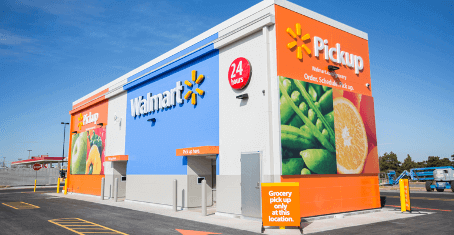
Amazon vs Walmart
Ranking right after Amazon on the list of e-commerce retailers is Walmart, which boasts 7.1% of US e-commerce market share as of February 2021. That may sound small in comparison to Amazon’s 40.4%, but Walmart has actually increased in market share this past year: the company surpassed eBay for the first time in 2020, securing a place as the second-largest e-commerce retailer in the United States.
Walmart, which was founded in 1962, has enjoyed success as a big box store in the United States. Currently, the company is the country’s largest retailer, although it has been predicted that it may be overtaken by Amazon in 2022. Walmart’s broad focus makes it comparable to Amazon in terms of product categories, as it offers everything from groceries to tech to auto and home goods. After suffering a decline in sales in 2015, Walmart chose to aggressively invest in e-commerce, making a multi-billion dollar investment into buying Jet.com, Bonobos, Eloquii, and ModCloth.
This investment has paid off, allowing Walmart to successfully employ an omnichannel strategy that drove e-commerce sales up in 2020. Furthermore, Walmart’s rival to Amazon Prime, Walmart+, has accumulated 9 million members since its launch in September 2020, with an estimated 20% of Walmart+ members migrating from Amazon Prime.

Walmart’s Strategy
Offering a wide variety of fulfillment options is key in Walmart’s strategy. Walmart has leveraged its widespread network of brick and mortar stores to boost e-commerce success. 90% of the US population lives within 10 miles of a Walmart, allowing consumers the control and flexibility of picking orders up curbside.
Curbside pickup has proved to be an important factor across multiple platforms: from February to June 2020 alone, the amount of American consumers who used curbside pickup grew from 7% to 22%. This is one area where Amazon lags behind, with only around 600 physical locations in the US (including locations such as Whole Foods, Amazon Books, Amazon Fresh, etc.).
Groceries, which are historically Walmart’s most prominent product category, also represent an important aspect of the retailer’s setup: grocery purchases keep consumers coming back to the store regularly, which triggers additional purchases in non-grocery categories. This aspect has contributed to the success of other grocery-centric e-commerce retailers, such as Kroger and Costco.
Amazon, recognizing the importance of both groceries and brick and mortar locations despite the pandemic, recently opened its Amazon Fresh grocery chain. However, it still falls far behind Walmart in terms of its physical network. Walmart’s brick and mortar advantage could be pivotal for its future success, particularly if American consumers continue to gravitate towards curbside pickup options.
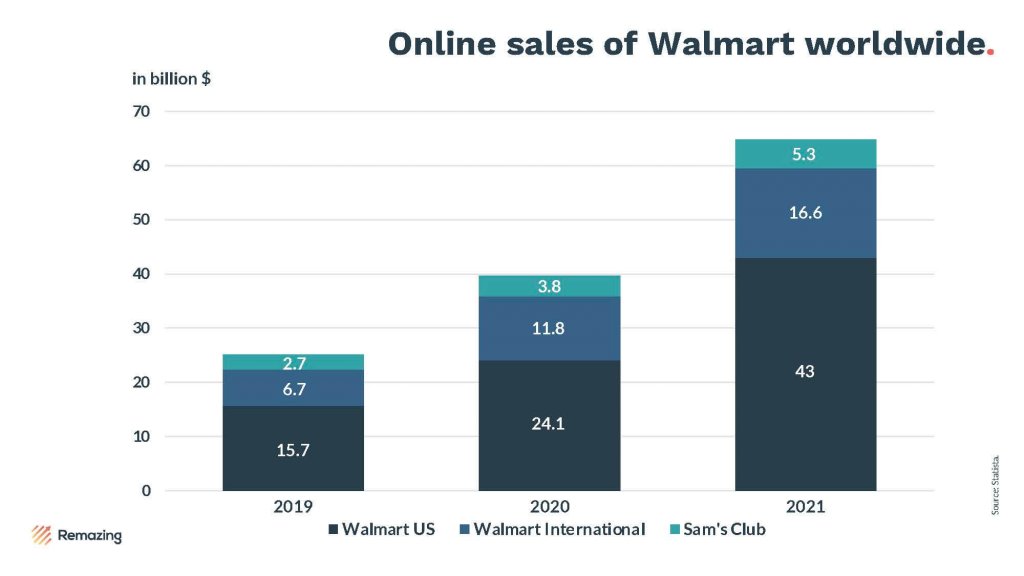
Selling on Walmart
In 2021, 39% of Amazon vendors and sellers reported that they were considering joining the Walmart platform, and 33% of Amazon sellers believed Walmart Marketplace will compete strongly with Amazon in 2021.
At the same time, not all sellers are eligible for Walmart. Walmart Marketplace limits seller eligibility to brands with at least a year of operating experience and good standing among customers. This can be considered a benefit for successful e-commerce sellers and more well-known brands, as they may face fewer competitors on Walmart Marketplace.
However, the marketplace, which previously required sellers to be registered in the U.S., has now opened eligibility to global brands in an attempt to close the e-commerce gap with Amazon. This means American brands will likely see increased competition from global brands, particularly from Chinese manufacturers.
To get an idea of whether a brand is likely to be eligible for selling on Walmart, one can look at the Amazon sellers that currently sell on Walmart. The majority of sellers fit the following profile:
- Private label business model (72%) with over 10 active product listings (70%; 29% currently sell over 100 products)
- 3 or more years of selling experience (60%)
- Self-employed or exclusively earn income through their e-commerce businesses (57%)
- Profit margins over 15% (60%)
- Lifetime sales over $100,000 (59%)
eBay

eBay’s Down, but Not Out
eBay was until recently the second-largest e-commerce retailer in the US as measured by market share. Although it has been unseated by Walmart in that ranking, it remains a relevant player: In terms of monthly visitors, the platform is second only to Amazon, with 688 million monthly US visitors to the site.
eBay has a reputation as an online flea market, and it’s true that people prefer eBay when they are shopping for secondhand goods. However, 80% of all goods sold on the platform are, in fact, new, with mobile and accessories as the most successful product category. eBay is frequented by users who are 30+ years old, making it an ideal platform for reaching an older target audience, particularly when the product is unique or obscure.
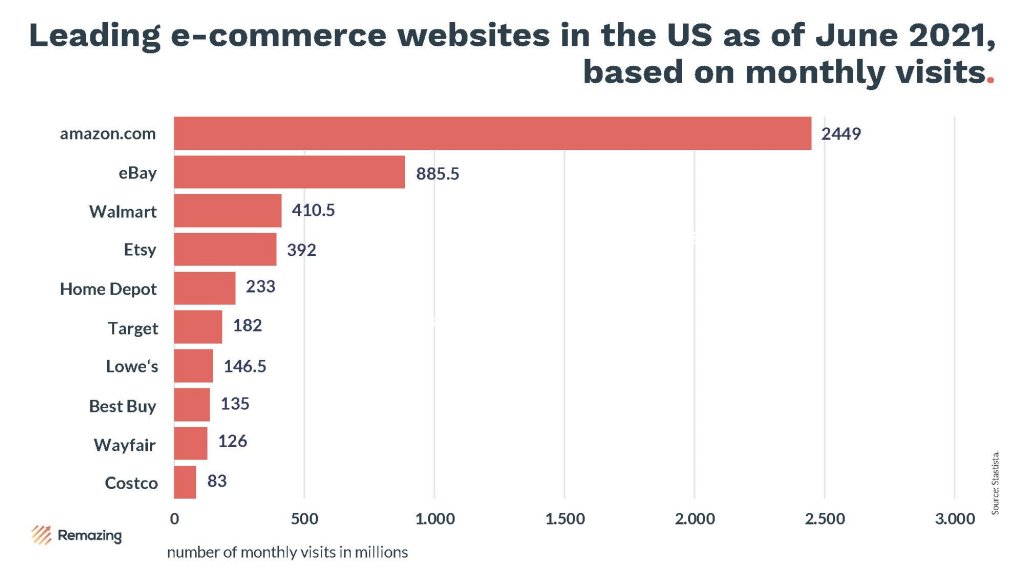
Selling on eBay
eBay is a particularly accessible marketplace, with no barriers to entry. In order to ship internationally, sellers have to meet a few requirements. They must:
- Have an eBay account in good standing
- Have earned at least 10 feedback points as a seller
- Have made their first successful sale more than 90 days ago
- Post in a category eligible for global shipping
While eBay currently only allows sellers to fulfill orders themselves, they have also done a test pilot of their own version of Amazon FBA. It has been announced that the eBay Fulfilment program will launch in the US at some point in 2022, with pricing competitive to Amazon FBA.
Best Buy

Subscribe to our newsletter now and receive regular updates on Amazon and other online marketplaces.
Subscribe to the newsletter now.
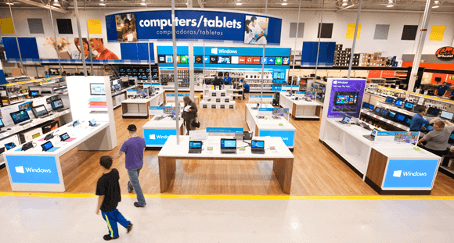
Best Buy’s Pandemic Success
Best Buy represents another pandemic success story driven by omnichannel adaptation.
Two main contributors to Best Buy’s growth include its switch to curbside pickup and its Geek Squad, which offers unique support and services that set it apart from competitors. During the fourth quarter of 2020, Best Buy’s web revenue increased 18.7% year over year, accounting for 25.4% of the company’s U.S. sales during the holiday period and all of the retailer’s growth.
As opposed to Walmart, Amazon and eBay, Best Buy has not historically sold a wide array of product categories. Instead, it is focused on tech, entertainment, and a selection of accessories and home office supplies. This focus was likely a benefit during the pandemic, as the company saw strong sales of computing equipment, tablets, and appliances as consumers transitioned to working and studying from home. Additionally, Best Buy’s Canada Marketplace offers opportunities for third party sellers in further categories such as baby essentials, furniture, fitness equipment and more.
Selling on Best Buy
The road to selling on Best Buy is not as simple as on platforms such as eBay, as Best Buy is more selective. In the U.S., companies can apply to be vendors at Best Buy by contacting the retailer and submitting selected SKUs for approval.
In Canada, interested companies also have the option of selling on Best Buy Marketplace. To do so, they must submit an application, which asks about the company’s presence on other online platforms, the country in which the brand’s shipping warehouse is located, estimated number of SKUs to launch, product categories, and ability to provide product content. Best Buy will then reach out to successful applicants about making an agreement and assisting with setup.
Target
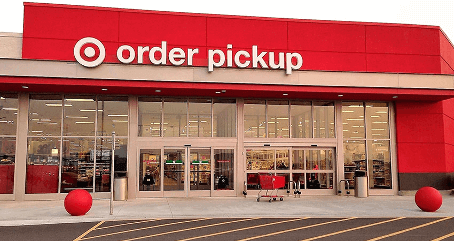
Target’s Pandemic Growth
Like Walmart and Best Buy, Target has also used its brick and mortar network and curbside pickup options to increase e-commerce sales. According to Indigo Digital, in the third quarter of 2020, Target’s Drive Up sales were up 500%, home delivery sales were up 280% and in-store order pickup was up 50%.
Target is positioned as a higher-end version of Walmart, in that it sells a variety of product categories alongside groceries, all at a slight premium. The wide product assortment means that Target can be a good fit for a wide variety of vendors, while the grocery offering brings in regularly returning consumers. Furthermore, Target’s audience differs from the consumers that regularly shop at Walmart: Target caters mainly to young, well-educated, moderate-to-better income families.
Selling on Target
Unlike Amazon, whose platform is rife with third-party sellers, Target typically only works with proven brands that the company believes will be successful on Target.com. The route to selling on Target includes submitting a convincing proposal and meeting the company’s supplier standards.
Home Depot

Home Depot Brings Digital Elements into Stores
For brands in the DIY space, Home Depot is the most important platform in the US market. Home Depot consistently outperforms its rivals, and, like other companies listed in this article, thrived during the coronavirus pandemic, as Americans turned their attention to home improvement projects, such as building home office and guest room additions. Total sales for the company hit $37.5 billion in 2020, up 32.7% year over year.
One of Home Depot’s main strategies has been to seamlessly coordinate its online experience with its in-store experience. Digital signs inside Home Depot locations make it possible for customers to see ratings and reviews of merchandise on the shelves, and the Home Depot digital product locator maps customers directly to the product they are looking for. Aspects like augmented reality shopping, so online shoppers can visualize how products would fit into spaces in their homes, and the site’s visual search function, make for a superior online shopping experience.
Selling on Home Depot
Like Best Buy and Target, interested suppliers must fill out a proposal form that convinces Home Depot that their product is worth selling. Applications should include considerations about how to market the product, and it is necessary that products comply with all local, state and federal guidelines regarding environmental, insurance and labor standards. The challenge lies in standing out from the competition and proving that the product will add value to the Home Depot selection.
Wayfair

Wayfair’s Mixed Success
Wayfair is a home goods and furniture retailer which operates almost exclusively online, originally launched out of the consolidation of 250 individual home furnishing websites in 2002. Operating on a dropship model, the website does not own most of the items it sells. Despite benefiting from consumers’ desire to redecorate their homes during the pandemic, Wayfair continues to lose money on most of its sales and is still searching for a sustainable business model.
Selling on Wayfair
If a brand fits Wayfair’s home goods product niche, it can apply via Wayfair’s online application. Wayfair is attractive for sellers: because it has no setup or selling fees and will pay for shipping, it can be a more affordable option than Amazon.
Takeaways
While Amazon remains to be the biggest player in the US e-commerce market, likely for the foreseeable future, there is a wide breadth of other marketplaces that brands should consider for a sustainable e-commerce strategy. Selling on growing platforms such as Walmart and Target, which have a dense brick and mortar network, can help brands reach consumers with fulfillment preferences that Amazon can’t currently meet.
Walmart in particular should be the first consideration for any eligible brand, as it is currently Amazon’s biggest competitor. With Walmart’s agile omnichannel strategy, the retailer is poised to continue to grow in coming years. Furthermore, with the company opening up to international vendors, the time is ripe for non-American vendors to strike.
Beyond Walmart and Target, brands’ product categories are the most relevant determiner for whether it makes sense to sell on other bigger American platforms. As long as the target audiences and category are a good fit, retailers such as Wayfair, Best Buy, Home Depot and eBay can be valuable approaches to diversifying across the US market.
Since many of the top US e-commerce retailers tend to sell larger, proven brands, it may take the right pitch and marketing strategy to convince retailers that European brands are worth their time. However, making the jump from selling on Amazon to other US platforms could be the move that makes the difference between selling and seeing sustainable growth on the US market.
Are you interested in an expert analysis of your Amazon account?
Request free analysisRemazing GmbH
Brandstwiete 1
20457 Hamburg
©Remazing GmbH




